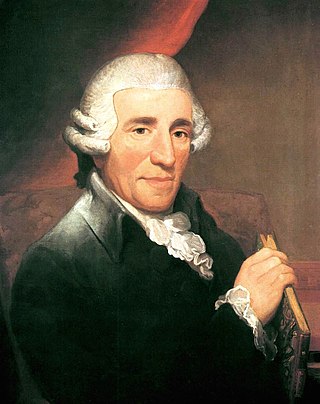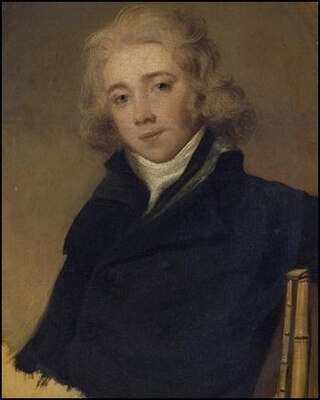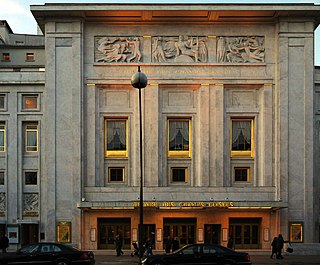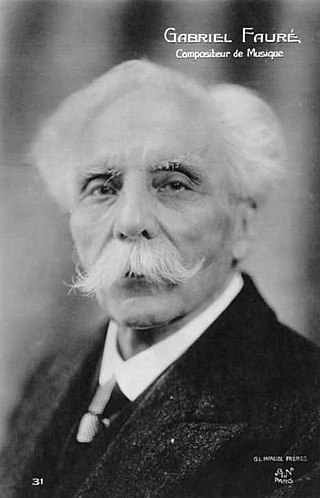Notes, references and sources
Notes
- ↑ Ideas for the trio had begun to form in his mind as early as 1921. [4]
- ↑ Napoli was played by Marcelle Meyer and the chansons were sung by Pierre Bernac. [7]
- ↑ Keith Daniel (1982) and Roger Nichols (2020) name Chabrier, Debussy, Satie and Stravinsky. [10]
- ↑ Une seconde audition … permettait d'y saisir, encore plus qu'à la première, et plus particulièrement au cours de l'Andante et du Rondo,!a rare délicatesse de l'instrumentation, ainsi que la subtilité de certains problèmes de forme résolus par l'auteur: tant mélodiquement que du point de vue instrumental ou formel, toujours une feinte négligence n'y fait que couvrir cette plénitude du métier … [8]
Related Research Articles

Francis Jean Marcel Poulenc was a French composer and pianist. His compositions include songs, solo piano works, chamber music, choral pieces, operas, ballets, and orchestral concert music. Among the best-known are the piano suite Trois mouvements perpétuels (1919), the ballet Les biches (1923), the Concert champêtre (1928) for harpsichord and orchestra, the Organ Concerto (1938), the opera Dialogues des Carmélites (1957), and the Gloria (1959) for soprano, choir, and orchestra.
The Sonate pour flûte et piano, FP 164, by Francis Poulenc, is a three-movement work for flute and piano, written in 1957.

The Variations and Fugue on a Theme by Mozart, Op. 132, is a set of variations for orchestra composed in 1914 by Max Reger; the composer conducted the premiere in Berlin on 5 February 1915. He later produced a version for two pianos, Op. 132a, where the Variation 8 ("Moderato") is completely different.

The Symphony No. 72 in D major is a symphony by Joseph Haydn. The symphony was probably composed between 1763 and 1765. The date of this composition is earlier than its number suggests. This work is not well chronologically placed in the Hoboken numbering system: it was composed fifteen to twenty years before the neighboring works.
Michael Haydn's Symphony No. 36 in B-flat major, Perger 28, Sherman 36, MH 475, written in Salzburg in 1788, is the last B-flat major symphony he wrote, the third of his final set of six symphonies.

Hyacinthe Jadin was a French composer who came from a musical family. His uncle Georges Jadin was a composer in Versailles and Paris, along with his father Jean Jadin, who had played bassoon for the French Royal Orchestra. He was one of five musical brothers, the best known of whom was Louis-Emmanuel Jadin.
Stabat Mater, FP 148, is a musical setting of the Stabat Mater sequence composed by Francis Poulenc in 1950.
Miguel del Águila is an Uruguayan-born, American composer of contemporary classical music.
Francis Poulenc's Concerto pour deux pianos in D minor, FP 61, was composed over the period of three months in the summer of 1932. It is often described as the climax of Poulenc's early period. The composer wrote to the Belgian musicologist Paul Collaer: "You will see for yourself what an enormous step forward it is from my previous work and that I am really entering my great period." The concerto was commissioned by and dedicated to the Princess Edmond de Polignac, an American-born arts patron to whom many early-20th-century masterpieces are dedicated, including Stravinsky's Renard, Ravel's Pavane pour une infante défunte, Kurt Weill's Second Symphony, and Satie's Socrate. Her Paris salon was a gathering place for the musical avant-garde.

Emil Hlobil was a Czech composer and music professor based in Prague.

Josef Triebensee (Trübensee) was a Bohemian composer and oboist.
Francis Poulenc's Sextuor (Sextet), FP 100, is a chamber music piece written for a standard wind quintet and piano. Estimates about the time of its composition range from between 1931 and 1932 and 1932 alone. It received its debut in 1933 but was later revised in 1939. Performed in its entirety, the three-movement piece lasts approximately 18 minutes.
The Sonata for two clarinets, FP 7, is a piece of chamber music composed by Francis Poulenc in 1918. Dedicated to Édouard Souberbielle, its total execution time is about six minutes. It is unusual among clarinet duets in that it is written for B♭ clarinet, which generally plays the melodic themes, and A clarinet, which plays a more supporting role through much of the piece. It is also unusual for music of this period that the clarinetists perform different time signatures simultaneously in parts of the opening movement.

The Sonate pour clarinette et basson, FP 32a, is a piece of chamber music composed by Francis Poulenc in 1922.

The Sonate pour violon et piano, FP 119, by Francis Poulenc was composed in 1942–1943 in memory of the Spanish poet Federico García Lorca. The score, dedicated to Poulenc's niece Brigitte Manceaux, was published by Max Eschig. The work was premiered by the violinist Ginette Neveu with the composer at the piano on 21 June 1943 in Paris, Salle Gaveau.
The Sonate pour cor, trompette et trombone, FP 33a, by Francis Poulenc is a piece of chamber music composed in 1922 and dedicated to Raymonde Linossier (1897–1930). Poulenc revised it in 1945. Its total performance time is about eight minutes.
Aubade, a choreographic concerto for piano and 18 instruments, is a work of Francis Poulenc premiered in 1929. It was conceived as a ballet, but is more often played as a chamber piano concerto.
The divertimenti in F major, B-flat major, E-flat major, F major, and B-flat major are five companion compositions for pairs of oboes, horns and bassoons by Wolfgang Amadeus Mozart.

The Cello Sonata No. 2 in G minor, Op. 117 is the second of the two cello sonatas by Gabriel Fauré.
The bassoon repertoire consists of pieces of music composed for bassoon as a principal instrument that may be performed with or without other instruments. Below is a non-exhaustive list of major works for the bassoon.
References
- ↑ Hell (1959), pp. 17–21 and 28
- ↑ Nichols, p. 348
- 1 2 Nichols, p. 62
- 1 2 Simeone, Nigel (2020). Notes to Resonus CD RES10256
- ↑ Caré, pp. 11–12
- ↑ Caré, p. 12
- 1 2 Nichols, p. 71
- 1 2 "Concerts de la Revue Musicale", Le Ménestrel , 14 May 1926, p. 223
- ↑ Schmidt, p. 149
- ↑ Daniel, quoted in Nichols, p. 64
- ↑ Nichols, p. 64
- ↑ Poulenc and Southon, p. 240
- 1 2 Nichols, p. 65
- ↑ Hell (1978), p. 82
- 1 2 3 4 5 6 Mellers, p. 14
- ↑ Hell (1978), p. 83; and Nichols, p. 64
- ↑ Mellers, 14; and Hell (1959), p. 33
- 1 2 3 Mellers, p. 15
- ↑ Hell (1978), p. 83
- 1 2 Caré, p. 14
- 1 2 Hell (1978), p. 84
- ↑ Hell (1959), p. 32
- ↑ Deeter and Peavler, p. 3; and Poulenc and Southon, p. 241
- ↑ Layton, Robert. "Honegger/Poulenc Perform their own works", Gramophone, June 1994
- ↑ Crutchfield, Will. "Recordings; A Wellspring From Poulenc's Song Legacy", The New York Times, 17 January 1988
- ↑ Decca 4757097
- ↑ DG 4276392
- ↑ Cala CACD1018
- ↑ RCA 88985321992
- ↑ Warner Classics 9185142
- ↑ Hyperion CDA67255/6
- ↑ Deux-Elles DXL1121
- ↑ Marquis 81403
Sources
- Caré, Claude (2013). "La Musique de chambre de Francis Poulenc" (PDF). Francis Poulenc (in French). Association des amis de Francis Poulenc. Retrieved 7 April 2020.
- Deeter, Alissa; Robert Peavler (2013). The Mélodies of Francis Poulenc: A Study Guide. Lanham: Scarecrow Press. ISBN 978-0-8108-8415-1.
- Hell, Henri (1959). Francis Poulenc. New York: Grove Press. OCLC 1268174.
- Hell, Henri (1978). Francis Poulenc (in French) (second ed.). Paris: Fayard. ISBN 2-213-00670-9.
- Mellers, Wilfrid (1995). Francis Poulenc . Oxford and New York: Oxford University Press. ISBN 978-0-19-816338-1.
- Nichols, Roger (2020). Poulenc. New Haven: Yale University Press. ISBN 978-0-300-22650-8.
- Poulenc, Francis (2014). Nicolas Southon (ed.). Articles and Interviews – Notes from the Heart. Burlington, US: Ashgate. ISBN 978-1-4094-6622-2.
- Schmidt, Carl B (2001). Entrancing Muse: A Documented Biography of Francis Poulenc. Hillsdale, US: Pendragon Press. ISBN 978-1-57647-026-8.